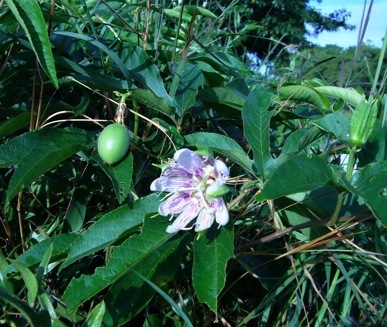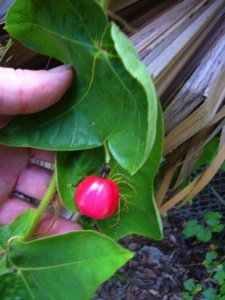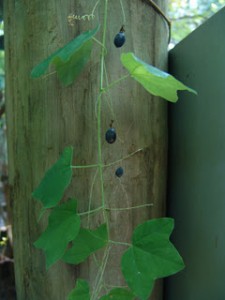Maypops: Food, Fun, Medicine
As popular as they are, Maypops get stepped on a lot, but that doesn’t keep them down.
They are one of five hundred kin in the passion flower family, specifically Passiflora incarnata (pass-siff-FLOR-ruh in-kar-NAY-tuh.) Passiflora means “passion flower” and incarnata means “in the flesh.” A relative, Passiflora edulis (pass-siff-FLOR-ruh ED-yoo-liss = edible) is used to flavor Hawaiian Punch. When the flowering vine was first discovered by Spanish explorers in Florida in 1529 the shape of the blossom captured their imagination and they described it as a symbol for the “Passion of Christ.”
Passion flowers do have complex blossoms. P. incarnata is two to three inches across with 10 white tepals in a shallow bowl with a fringe of purple and white filaments, called a corona. The center is a white stigma with five stamens. The vine is long and trailing with three-lobed leaves. The vines blossom for a long time and set fruit over the same period so one vine can have old and young fruit at the same time. Shaped like a egg, the fruit starts out green and hollow and eventually fills with a kind of jelly and seeds while also turning yellow on the outside. Finding the fruit is rather sporadic since woodland creatures like them as well and dine at night. Caution: Maypops’ green skin is edible raw but too many can burn the mouth. The rind is better cooked. The pulp-covered seeds in a green or yellow maypop are quite edible.
“Maypops” is a two-season name. Here in Florida and other parts of the south they can blossom in May. But the fruits don’t get big enough to step on and “pop” until June or July. The name comes from “maracock” which is what the Powhatan Indians called it. And though thought of a “southern” wild fruit, Maypops grow as far north as Pennsylvania and west to Kansas, south to Texas, central Florida and Bermuda. Under cultivation P. incarnata likes full sun to partial shade, light, evenly moist soil. Deciduous, it can take temperatures down to 5F. In the wild they grow in sunny areas with good drainage, at the top of a berm, not the bottom. Many caterpillars like the Maypop including the Gulf Fritillary and Zebra Wing Butterfly.
If you find a tiny passion flower that is off yellow with small fruit that’s deep purple/black when ripe, it’s the Passiflora lutea (LOO-tee-uh = yellow) edible but not too tasty, used to make ink. It likes to grow in wet areas. Don’t mistake it for a wild cucumber, Melothria pendula, which have leaves that smell like cucumber. When M. pendual’s fruit is black it’s the Mother of all Laxatives. The Passiflora suberosa (sou-ber-OH-sah = corky) with blue fruit is also edible (the fruit.) The Passiflora foetida, common in south Florida, has red fruit as is edible as well, quite tasty with very thin skin.
Oddly, while native to North America, Maypops are far more popular in Europe. Americans used make jelly out of them, Native Americans cooked the leaves in fat. Europeans currently make pharmaceuticals. The fresh and dried whole plant has been used to treat nervous anxiety and insomnia. It is the most common ingredient in herbal sedatives in Europe. In Europe a teaspoon of dried, ground plant is used in a tea. Even a sedative gum has been made with Maypop. The active ingredient(s) is unknown. See the “herb blurb” below. Perhaps the Maypop vine is medicinal: It smells and tastes bad, as does most medicine that is good for you. What does the vine smell like? Like an old rubber shoe. The fruit, fortunately, does not share that…. too much. Oh, and this will not make sense until you consider the general shape of the leaves and fruit: The Maypop is a relative of the papaya.
Other Passifloras with edible fruit include: P. alata, P. ambigua, P. ampullacea, P. antioquiensis, P. caerulea, P. coccinea, P. cumbalensis, P. x decaisneana, P. edulis f. flavicarpa, P. laurifolia, P. lingularis, P. maliformis, P. manicata, P. mixta, P. mollissima, P. organensis, P. pinnatistipula, P. platyloba, P. popenovii, P. quadrangularis, P. serrato-digitata, P. tripartita, and P. vitifolia.
Lastly, the Internet is the Great Garbage Can of Misinformation and amateur writers. Of late sites have been proliferating the nonsense that Passiflora incarnata has cyanide in it. It categorically does not. The American Pharmaceutical Association Practical Guide to Natural Medicines by Andrea Peirce states: “Unlike other Passiflora species, … [the] Passionflower does not contain the poison cyanide, as some sources incorrectly suggest; they may have mistaken Passiflora incarnata for Passiflora caerulea, the ornamental blue passionflower that does contain this toxin.”
Passiflora foetida does have some cyanide in it as evidenced by some research on goats feeding on the foliage. However, I have eaten a fruit or two at a time with no problem. Goats, of course, eat leaves so they can get a higher concentration of cyanide. The passion fruit used in Hawaiian Punch, Passiflora edulis, has to be limited to goats as well, less than 45 percent of their feed.
I would add that cooking or sometimes mascerating green parts of edible plants with small small amounts of hydro- or glycocyanides releases the cyanide. Also note the “Herb Blurb” below. P. incarnata has some MAO inhibitors. MAO inhibitors and chocolate should not be combined.
Maypop Jelly
2 cups ripe maypops, sliced
1 cup water
2-1/2 cups sugar
1-3/4 ounces pectin
Combine the maypops and water, and boil gently for five minutes. Strain, discarding the pulp. Combine the liquid and sugar and bring to full rolling boil. Add pectin, and again bring to rolling boil. Remove from heat, pour into hot, sterilized jars, and seal. Makes 2-1/2 pints.
Green Deane’s “Itemized” Plant Profile
IDENTIFICATION: (Passiflora incarnata) The passion flower is a woody vine that grows up to 30 feet long and climbs with tendrils. It has striking, large white flowers with pink or purple centers. Leaves are three lobed and the fruit egg-shaped going from green to yellow or orange when ripe.
TIME OF YEAR: In Florida it starts fruiting in June with early fruit ripening around August. Farther north the ripening is towards fall. Can be propagated by seed or cutting, cuttings are slow to root.
ENVIRONMENT: Maypops grow in thickets, disturbed ground, unkept pastures, roadsides and railroads. They like full sun and water but good drainage. You will not find them in damp areas.
METHOD OF PREPARATION:Green and yellow ripe maypops off the vine, though larger green ones are better than small ones. They can be made in to a jelly or an ade. Green ones better cooked than raw, yellow ones are nice raw. Leaves can be cooked like a green. With other passionflower eat only the fruit.
HERB BLURB:
According to the Memorial Sloan-Kettering Cancer Center Website: Derived from the aerial parts of the plant. Patients use this herb to treat insomnia, anxiety, epilepsy, neuralgia, and withdrawal syndromes from opiates or benzodiazepines. The active component of passionflower is unknown. The alkaloid components (e.g. harman, harmaline) are thought to produce monoamine oxidase inhibition, while the maltol and gamma-pyrone derivatives cause activation of GABA receptors (4). Reported adverse events include sedation, dizziness, impaired cognitive function, and one case report of nausea, vomiting, and ECG changes. All adverse events subside following discontinuation of passionflower (7) (8). Theoretically, passionflower may potentiate the sedative effect of centrally acting substances (e.g. benzodiazepines, barbiturates, alcohol) (10). A small pilot study evaluated passionflower for generalized anxiety and showed comparable efficacy to oxazepam (8), but a systematic review concluded that randomized controlled studies are needed to confirm such effects (12). Passionflower may be of use in combination with clonidine for opiate detoxification, but additional research is required. No standardization exists for passionflower extract, therefore dosages and activities may vary.




